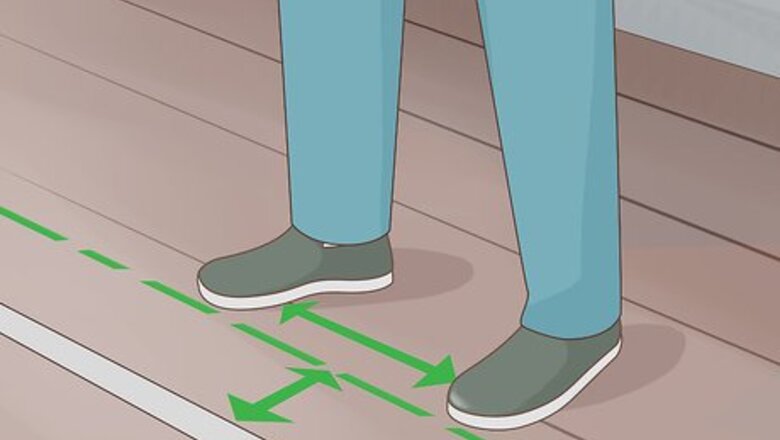
views
- Get into a throwing stance with your shoulders straight, feet hip-width apart, and your dominant foot turned towards the center of the dartboard.
- Grip the dart with 3 fingers, holding it steady but not tightly. Raise the dart to eye level and tilt the tip upward, aligning it with your target on the board.
- Throw the dart with your hand and wrist, snapping your wrist as you release the dart and following through with the movement at the end of the throw.
Getting into the Throwing Stance
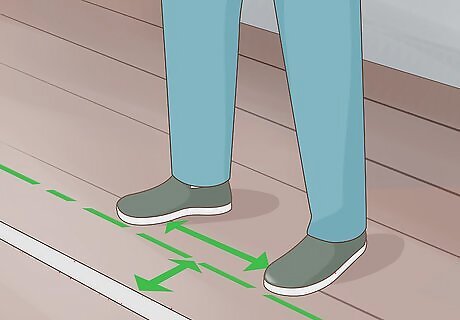
Stand with your feet hip width apart behind the throw line. The throw line, also called the oche, cannot be stepped over at any time when you are throwing darts.
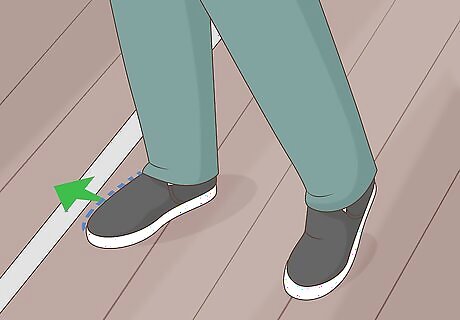
Face the dartboard sideways with your dominant foot forward. Your feet should be facing towards the side of the room, rather than towards the throw line. If you are right-handed, your right foot will be forward, with your big toe just behind the throw line. Your left foot will be on the floor just behind your right foot. If you're left-handed, your left foot will be forward and your right foot will be behind your left foot. Your dominant hand should be forward, loose next to your dominant foot. So if you are right-handed, your right hand will be forward. If you are left-handed, your left hand will be forward. It's okay if your back heel raises a bit off the floor in this stance. Do not lift your back foot up though. Make sure you are still putting weight on it. Avoid standing with your body facing the dartboard head on, as this is not a very stable stance. Facing to the side of the dartboard will help you develop a more accurate throw.
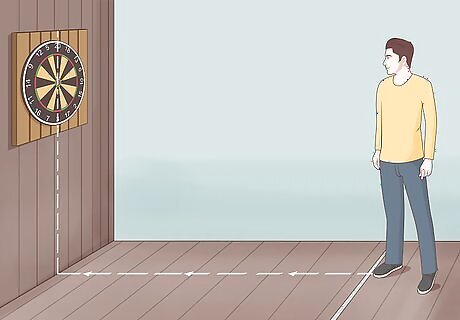
Turn your front foot towards the center of the dartboard. Draw an imaginary line from the center of the dartboard to the floor. Make sure your front foot is pointing towards the imaginary line on the floor. This will help to keep your dart throws straight and accurate. Keep your other foot turned to the side. Your body should remain turned slightly to the side, even though your front foot is angled forward. You can mark the spot on the floor with your shoe so you know where to line up your front foot every time you throw.
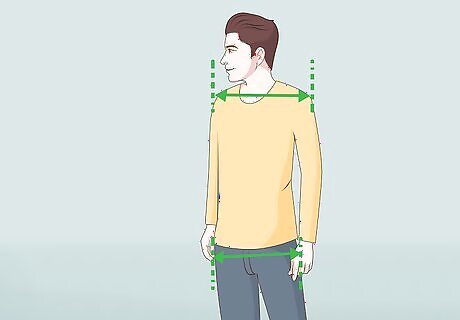
Maintain straight shoulders and hips. Do not slouch over or roll your hips back. Keep your shoulders and hips stacked on top of each other. You want to keep your shoulders, hips, and legs straight at all times when you are throwing darts. Some dart players will lean their upper body slightly forward over the throw line to feel more comfortable in their stance and get closer to the board. You can do this as long as your legs or feet do not cross the throw line. However, leaning too far forward can compromise your stance and your throw.
Gripping and Aiming the Dart
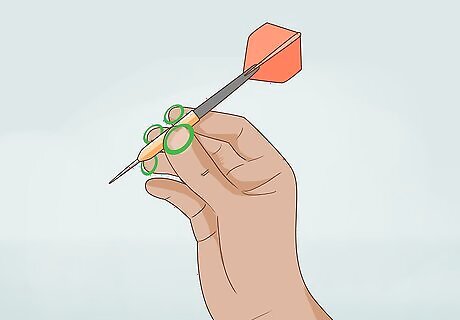
Hold the barrel of the dart with at least three fingers. The barrel is the raised part on the dart, closer to the center of the dart. Grip the barrel of the dart with your thumb, forefinger, and middle finger. You can then also hold it at the end of the barrel with your ring finger if you want a more stable grip. Do not hold the dart at the tip of the dart or at the flight, which is at the very back of the dart. Do not curl your fingers as you grip the dart. Instead, keep them long and open. Keep in mind a dart with a shorter barrel will usually require fewer fingers for gripping. A dart with a longer barrel may require more fingers to maintain a good grip.
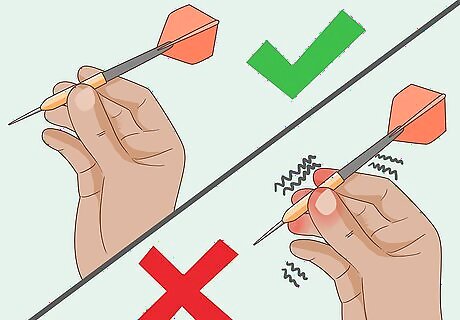
Keep your grip stable but not too firm. Do not grip the dart so tightly that your fingers turn white or the muscles in your fingers feel tense. Darts is a game of touch, rather than force. Your grip should be just tight enough to keep the dart in place and maintain control over it. When in doubt, go for a grip that is loose rather than firm. You can then adjust your grip so it is a bit tighter as needed.
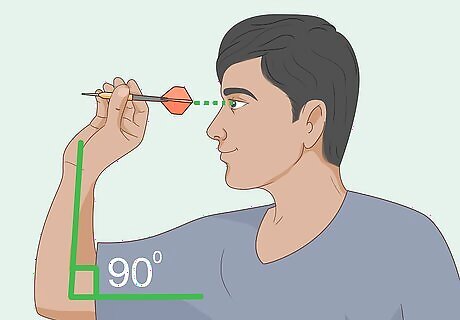
Raise the dart to eye level. Swing your front arm forward, gripping the dart with your fingers. Keep your shoulder still as you raise the dart to eye level, just to the side of your eye. Make sure your elbow is pointing at the dartboard. Your shoulder, elbow, and hand should all be aligned, forming a 90 degree angle, with your elbow slightly up.
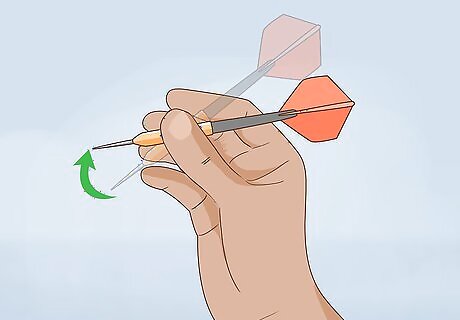
Tilt the tip of the dart slightly upward. Keep the end of the dart tilted upward slightly, towards the dartboard. Do not let the tip drop downward or to the side, as this will affect your aim.
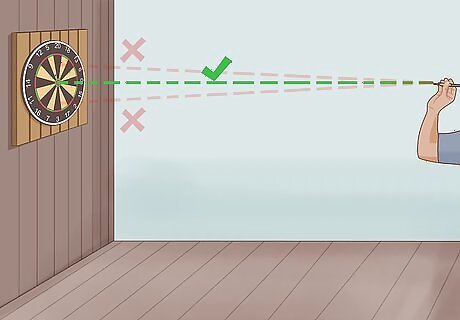
Align the tip of the dart with your target on the board. Do not aim to the right or left of your target, as this will usually lead to a poor throw.
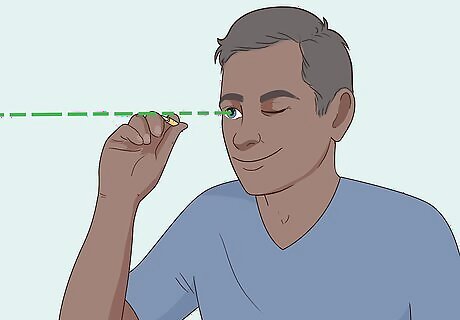
Use your dominant eye to help you aim. Your dominant eye is usually on the same side as your dominant hand. So if you are right-handed, your right eye will be the dominant one. Try looking at the board with your dominant eye open and your other eye closed to help you aim.
Releasing the Dart
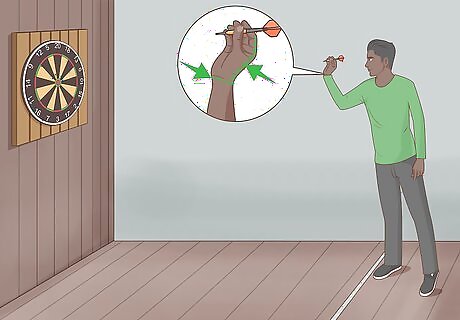
Throw the dart with your hand and wrist. Pull your hand slightly back as you throw. Use your hand, wrist, and elbow for speed. Keep your shoulder still for support. Place more weight on your front foot as you throw the dart. Do not lean or sway to the side. Keep your body still and straight. Only your arm should be moving when you throw the dart. Your elbow may raise up slightly when you throw the dart. This is okay, as it may move upward due to the force of your throw.
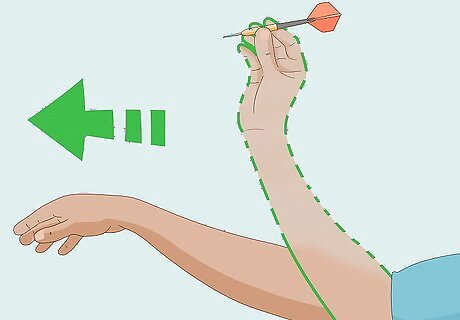
Snap your wrist as you release the dart. Let your wrist snap forward as you release the dart. Make sure your wrist does not snap downward, as this will cause the dart to fly downward. The wrist snap is often done by professional players to increase the acceleration of the dart. It can also result in a more accurate and consistent throw.
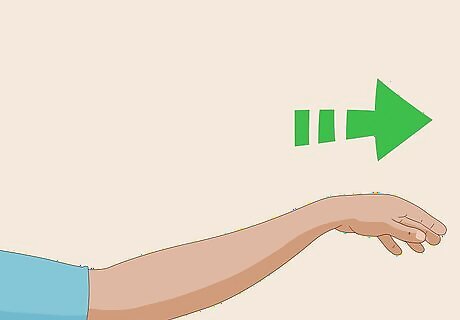
Follow through at the end of the throw. Once you have released the dart, let your arm continue in a throwing motion so your fingers are pointing towards your target, or down at the floor. Allow your arm to hover in the air for a moment before you drop it down. This will help you maintain good form at the end of your throw.
Getting Better at Darts
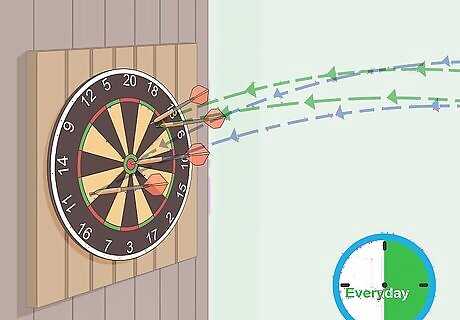
Practice once a day. A big part of being good at darts is consistency. Improve your throw by practicing darts at least once a day for 30 minutes to 1 hour. Aim at different targets on the dartboard. Challenge yourself to hit the same target in a row. The more you practice, the better your darts game will be.
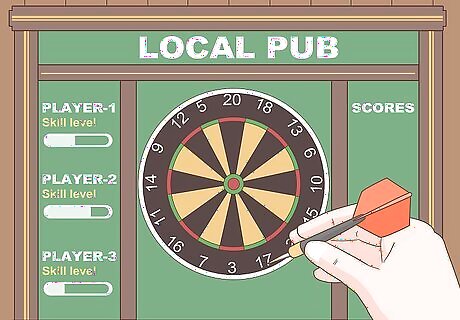
Participate in public games. Strike up a friendly game of darts at your local pub. Invite friends over to play darts at your house. Play against dart players of different skill levels and styles to improve your technique.
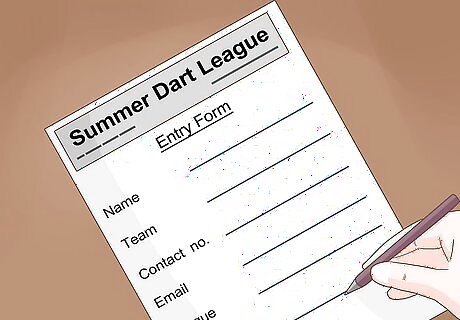
Join a darts league. To get in the habit of playing darts regularly, look for a darts league in your area. Ask around at your local bar or form your own league with friends. You can then enter local darts competitions or contests and compete against others as a team.



















Comments
0 comment